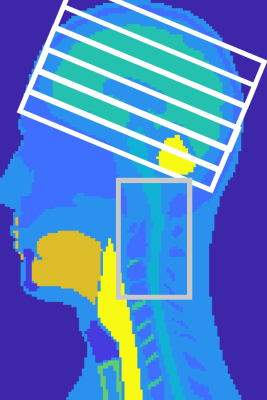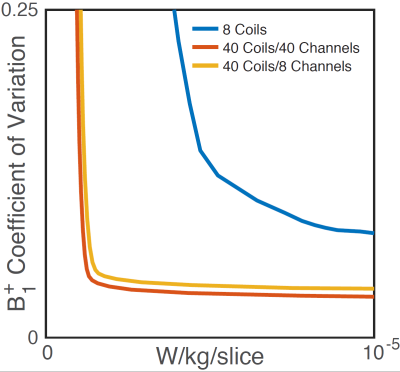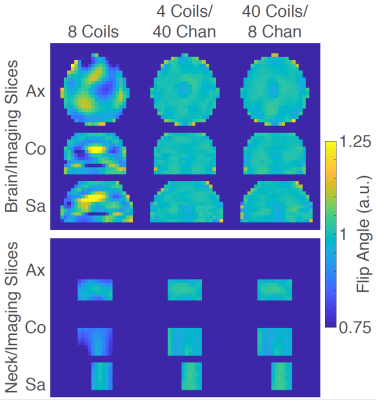3289
Optimizing an Array-Compressed Coil for Arterial Spin Labeling at 7T
Xinqiang Yan1,2, Manus J. Donahue1,2, and William A. Grissom1,2,3
1Department of Radiology, Vanderbilt University Medical Center, Nashville, TN, United States, 2Institute of Imaging Science, Vanderbilt University, Nashville, TN, United States, 3Department of Biomedical Engineering, Vanderbilt University, Nashville, TN, United States
1Department of Radiology, Vanderbilt University Medical Center, Nashville, TN, United States, 2Institute of Imaging Science, Vanderbilt University, Nashville, TN, United States, 3Department of Biomedical Engineering, Vanderbilt University, Nashville, TN, United States
Synopsis
Arterial spin labeling (ASL) is a primary approach for non-invasive perfusion measurements with MRI. Theoretically, performing ASL at ultrahigh magnetic field strength can be beneficial because of the increased SNR as well as the lengthened T1-relaxation time. However, ASL is still not widely used at 7T due to the obstacles of B1+ inhomogeneity and high SAR associated with labeling. To overcome this problem, we apply array compressed parallel transmission (acpTx) in ASL and find that the optimized coil achieved 2x better B1+ homogeneity, and 4x lower SAR than a conventional 8-channel coil, which could enable 7T ASL with neck labeling.
Purpose:
Arterial spin labeling (ASL) [1-3] is a primary approach for non-invasive perfusion measurements with MRI. Theoretically, performing ASL at ultrahigh magnetic field strength can be beneficial because of the increased SNR as well as the lengthened T1-relaxation time [4]. However, ASL is still not widely used at 7T due to the obstacles of B1+ inhomogeneity and high SAR associated with labeling. In ASL, it is attractive to have a separate labeling coil to eliminate the magnetization-transfer (MT) effect, but this requires specialized hardware such as detuning/switches and control circuits [5]. Standard 7T scanners are equipped with multiple transmit channels. This architecture enables the separate control of labeling coil without any additional hardware. Due to limited transmit channels, however, it is quite challenging to balance the excitation performance in the human brain and the labeling area. For example, conventional 8-element arrays have relatively low efficiency and ability to shape the excitation field in the labeling area. To overcome this problem, in this work, we apply array compressed parallel transmission (acpTx) [6], which enables the use of many-element transmit coils with limited transmit channels, in ASL and investigate how much improvement it can obtain.Methods:
Simulation models of an 8-coil loop transmit array (1x8) and a 40-coil loop transmit array (4x10) were generated (Fig. 1). Both arrays were mounted on a 29-cm-diameter cylindrical surface, to accommodate a 32-channel receive coil insert. The 8-coil loop array had a length of 21 cm and the 40-coil array had a total length of 24 cm. The loop coils were gapped in the same row and overlapped between adjacent rows. The layout of the 40-coil-array enables the combined use of self-decoupling and overlapping to solve the complex coupling between elements [7].Multislice RF shims were then designed with global SAR regularization for each array: the 8-element array, the 40-element array using 40 channels, and the 40-element array compressed to 8 channels. The shims were optimized over a volume of 20 degree-tilted brain slices, and over a neck volume for labeling (Fig. 2). The neck volume had dimensions 4 x 8 x 6 cm3 (A/P x R/L x H/F).
Results:
Fig. 3 plots B1+ coefficient of variation of the shimmed imaging and labeling slices, versus SAR for each coil. Even when compressed to 8 channels, the 40-element coil achieves a considerably better SAR-homogeneity tradeoff than the 8-coil array, and there is little loss incurred in compression. The knees of the curves have B1+ CoVs of ~0.04 (40-element coils) and ~0.1 (8-channel coil), and the 8-channel coil’s SAR is 4x higher. Fig. 4 shows shimmed B1+ maps in the imaging and labeling volumes for each setup, which further illustrate that the 40-element coil achieves a considerable improvement over the conventional 8-channel coil, even when compressed to the same number of channels.Conclusion:
acpTx was applied in this simulation study to optimize a 40-element/8-channel array for arterial spin labeling at 7T. Results showed that the optimized coil achieved 2x better B1+ homogeneity, and 4x lower SAR than a conventional 8-channel coil, which could enable 7T ASL with neck labeling.Acknowledgements
This work was supported by NIH grant R01 EB 016695.References
[1] Detre, J.A., Alsop, D.C., Vives, L.R., Maccotta, L., Teener, J.W., Raps, E.C., 1998. Neurology 50, 633–641. [2] Detre, J.A., Leigh, J.S., Williams, D.S., Koretsky, A.P., 1992. MRM. 23, 37–45. [3] Detre, J.A., Wang, J., 2002. Neurophysiol. 113, 621–634. [4] Zuo, Z., Wang, R., Zhuo, Y., Xue, R., Lawrence, K. S. S., & Wang, D. J. (2013). PloS one, 8(6), e66612. [5] Hetzer, S., Mildner, T., Driesel, W., Weder, M., & Möller, H. E. (2009). JMRI, 29(6), 1414-1424. [6] Cao, Z., Yan, X., & Grissom, W. A. (2016). MRM, 76(4), 1158-1169. [7] Yan, X., Gore, J. C., Grissom, W. A., ISMRM, 2018, p 4271.Figures

Fig 1: This
study compares the multislice RF shimming capabilities over the brain and neck
of an 8-channel conventional 7T head coil, versus a 40-element coil driven by 8
channels using acpTx.

Fig 2:
Illustration of the two target areas: the titled slices in the brain area and
for and the labeling area over a neck.

Fig 3:
SAR-versus-Shimmed B1+ homogeneity L-curves for
each coil setup.

Fig. 4: Shimmed B1+
maps in the imaging and labeling volumes for each setup.